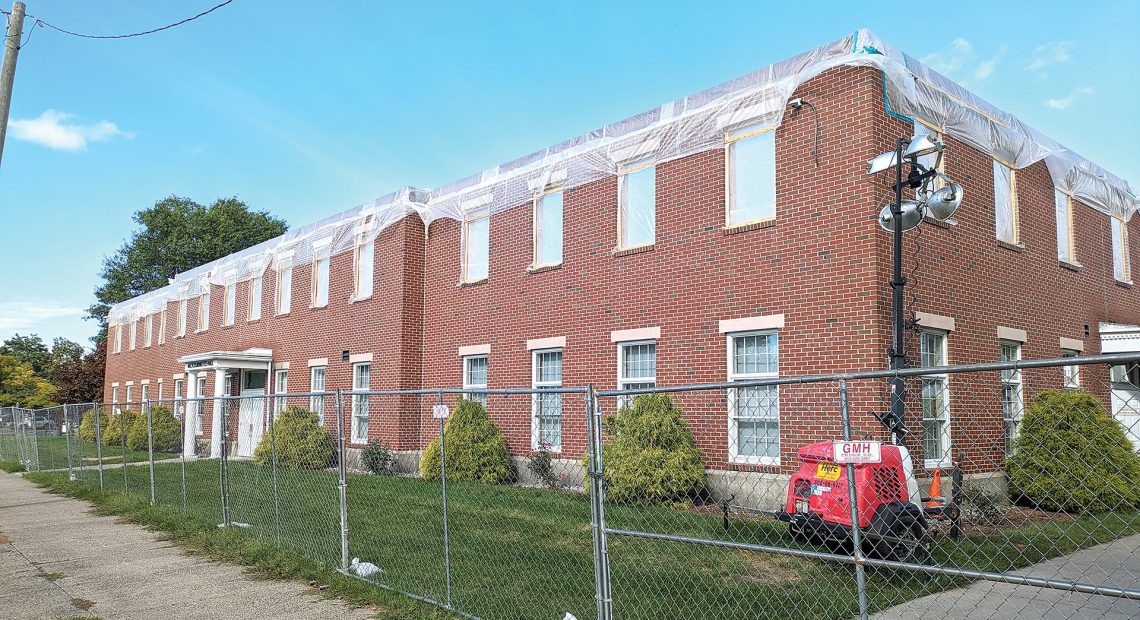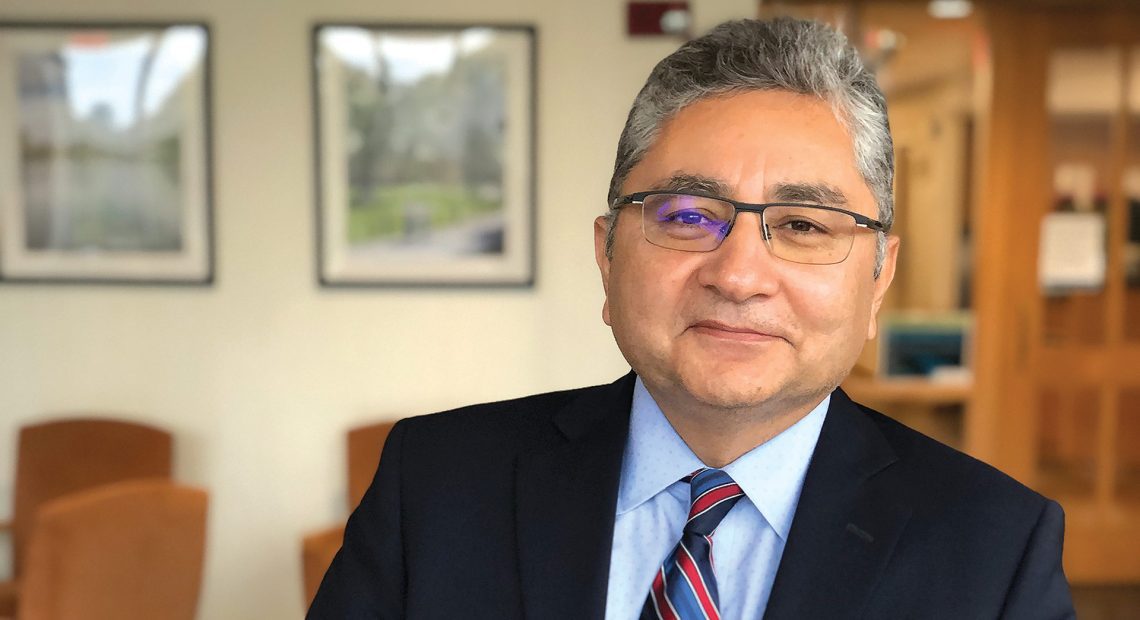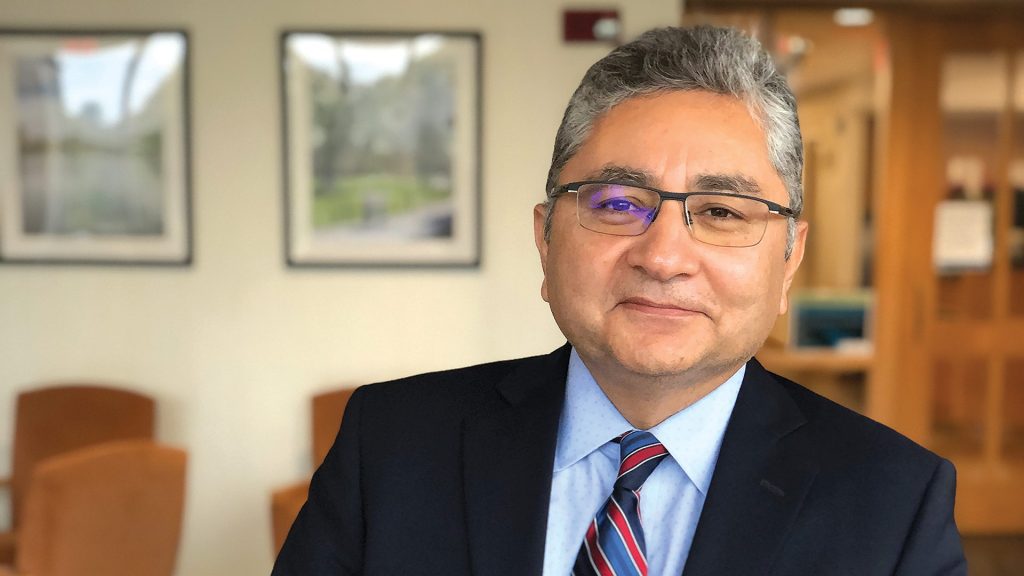Community Spotlight

An architect’s rendering of the renovated chapel at Wilbraham & Monson Academy, what students are calling the ‘Harry Potter dining hall.’
The students have started calling it the “Harry Potter dining hall,” and with good reason.
That’s the look that will be created by an ambitious initiative to transform the ornate but very much underused chapel at Wilbraham & Monson Academy (WMA) into a next-generation dining commons.
The undertaking, the second phase of a much larger strategic initiative that comes with an $18 million price tag, will enable the school to make far better use of not only the chapel, but the current dining hall, which will be converted into an auditorium and event space.
“This is going to be stunning,” Head of School Brian Easler said. “Because the music department is under the current dining hall, it will be a much more efficient use of space. Right now, we use the chapel once a week for 20 minutes for school meeting; other than that, it stays vacant, which is a shame because it’s the most beautiful building on the campus. So we’ll use the most beautiful building as the heart of the school.”
Perhaps the best part about all this, Easler said, is that the idea for converting the chapel into a dining hall came from a student, who was looking at a 3D scale model of the campus created by the architectural firm handing the project and put forth a powerful ‘what if?’ (more on that later).
Transformation of the chapel, the timing of which is dependent on fundraising — which is off to a solid start, according to Easler — is not the only landscape-altering development taking shape on or just off Main Street in Wilbraham.
Indeed, there’s also new construction just down the road from WMA, where, on the site of three demolished buildings, a mixed-use facility is taking shape, one that will house a brewery, an Italian restaurant, additional commercial businesses, and seven apartments.
This development, called the Center Village project — on top of other emerging and established success stories across town — is expected to spur new development in what is considered the town, or village, center, although it still doesn’t look much like a center, said Mike Mazzuca, chair of Wilbraham’s resurrected Economic Development Committee.
“We want to look at how we can create a true downtown for Wilbraham,” he said, noting that there is real potential for business to thrive beyond the Boston Road corridor.
Jeff Smith, another member of the committee and co-owner, with his wife, Amy, of one of those Wilbraham-based businesses, New England Promotional Marketing (NEPM), agreed.
“Back in the ’80s, there was a lot more going on in the town center, and it was used more,” he explained, noting, for example, that the post office was there before it was relocated to Boston Road. “Things changed, a couple of the buildings became vacant, and there was less and less activity there. Now that there will be more activity, we believe that will spur more development.”
Mazzuca added that, while one of the committee’s primary goals is to bring new commerce, vibrancy, businesses, and especially people to the town center, its larger mission is to send a message, loud and clear, that Wilbraham is ‘open for business.’
It always has been, he said, but it has also always been a mostly residential community and among the region’s unofficial ‘best places to live.’ It can still be that, he went on, while also building on a somewhat impressive portfolio of businesses — most of them small, most of them retail or service in nature, and most of them on Boston Road.
As it goes about its work, the Economic Development Committee will promote all that Wilbraham has to offer, said both Mazzuca and Smith, adding that there are many amenities on that list, starting with a single tax rate and continuing with available tax-increment financing; a vibrant business corridor (Boston Road) that boasts traffic counts of 12,000 cars a day; proximity to Springfield, Ludlow, Hampden, Palmer, and Monson; a diverse existing business base; high-speed internet; and more.
“We want to help out and be a liaison between the municipality, the permitting authorities, and the actual businesses, with the ultimate goal of getting that message across that we are open for business.”
Smith said the committee is working to parlay these assets and the current momentum in the town on Main Street, Boston Road, and beyond into new business opportunities.
For this, the latest installment of its Community Spotlight series, BusinessWest takes an in-depth look at Wilbraham and all that goes into that phrase ‘open for business.’
Food for Thought
As he recounted that now-famous session where students and the architects were discussing what should come next — and where — on WMA’s campus, Easler could hardly contain his sense of pride in the fact that one of his students had masterminded what will be the signature component of the largest building initiative at this private school in anyone’s memory.
“The architect was leading them through a brainstorming exercise, focusing on three primary questions: what do we need? Where should it go? And what should happen first?” he recalled. “We were at that part where he was asking them where things should go, and the specific question was ‘is the dining hall in the right place?’
“The kids were chatting and moving blocks around, when one of the boys said, ‘what if we made the chapel into a dining hall?’” Easler continued. “There was a nervous chuckle around the table for about five seconds, and then there was a 10-second pause where you could see the wheels turning in everyone’s head. And then there was just this ‘a-ha’ moment where everyone went, ‘that is an awesome idea.’”
And an idea that will become reality … soon, when enough money is raised to commence construction, said Easler, noting that fundraising, which involves almost exclusively alumni of the school, is progressing well, but there is a good amount still to be raised.

The mixed-use facility taking shape on Main Street in Wilbraham is expected to spur new development in the town center.
As noted earlier, renovation of the chapel is just part of a much larger undertaking designed to enable WMA to make better, more effective use of existing facilities, said Easler, noting that the chapel itself has served the school as a meeting place, and there simply haven’t been many meetings there.
The project also calls for the existing dining commons, on the other side of Main Street from the chapel and most classroom facilities, to be converted into an auditorium with stadium seating, with the existing kitchen to be used for back-of-house functions for that facility.
“This will have a really remarkable impact on the campus, and the town, actually — it will reduce pedestrian traffic on Main Street by about 70%,” Easler told BusinessWest, noting that dining facilities will now be on the same side of the street as classes, dramatically reducing the number of times students will have to cross the street each day.
Beyond that, it will give the arts program a functioning theater (the current dining hall), a dramatic improvement over existing ‘black box’ facilities, and the students will have the ‘Harry Potter dining hall.’
Wilbraham at a glance
Year Incorporated: 1763
Population: 14,613
Area: 22.4 square miles
County: Hampden
Residential Tax Rate: $18.70
Commercial Tax Rate: $18.70
Median Household Income: $65,014
Median Family Income: $73,825
Type of government: Board of Selectmen, Open Town Meeting
Largest Employers: Baystate Wing Wilbraham Medical Center; Friendly Ice Cream Corp.; Big Y; Home Depot; Wilbraham & Monson Academy
*Latest information available
And the school, which is currently at full enrollment, will be in an even better position to recruit young people to the campus, he said.
“Boarding school, and private school in general, is about the experience,” Easler said. “We have top-notch education, rigorous and supportive programs, lots of things people can do outside of academics … but a big reason people choose to invest in us is because it’s an experience they can’t get in a public school or a day school. And a big part of experience is having facilities like these to support it — like that dining room.”
Progress Report
There has been considerable momentum at WMA generated by several projects in recent years, including the building of a new athenaeum and conversion of the basement of the science building into a 5,000-square-foot innovation lab, and these advances constitute just some of the positive developments on Main Street and beyond in this community of around 14,600.
Michelle Buck, Wilbraham’s Planning and Community Development director, cited several signs of growth and progress across town.
That list includes several new developments on Boston Road, including a new Starbucks now under construction in front of Home Depot, once the site of a bank branch that was demolished; parking-lot expansion of the Lia Toyota dealership; a new Golden Nozzle car wash; a new fitness center called Cycle & Praise; and an outdoor dining facility for Route 20 Bar & Grille, as well as a large solar farm soon to be under construction on Three Rivers Road.
But the most visible — and most impactful — development, she said, is the emerging home for Scantic River Brewery, the ‘new’ Parfumi’s Pizza (the current version is right next door), seven apartments, and, hopefully, other small businesses. Center Village is an important development for the community, said all those we spoke with, not only because of what is planned for the site, but because of how it might make the town’s center more of a destination and spur additional development.
“It’s an exciting project that could bring more people to Main Street,” Buck said, adding that, while town leaders want to cluster most commercial activity on Boston Road, there is certainly opportunity for development in other areas of town.
Mazzuca agreed, and said bringing new businesses to Wilbraham is overarching mission of what would be called the ‘new’ Economic Development Committee, which has been working on a number of fronts simultaneously.
One has been bringing some of the businesses displaced by the closing and demolition of the nearby Eastfield Mall to the town. The committee helped secure Boston Road addresses for two of them — Mall Barbers and School of Fish — through the use of ARPA funds to help with relocation expenses.
The other major front has been ongoing work to bring more businesses and vibrancy to the downtown area, which, as Smith noted, was more of a destination 30 or 40 years ago, and can be again through developments like the Center Village project and others that might come to the drawing board because of it.
The broad goal, he said, is to create a walkable downtown and an attractive mix of businesses that will effectively serve those living in Wilbraham and surrounding communities.
“Looking north and south on Main Street, we have a farmers’ market now at the church once a week, and some activity at WMA,” he said. “So we want to look at the whole picture of the way vehicles and pedestrians interface, and revamp that. The first concern would be safety, and the second would be convenience — and it’s convenience that attracts people. There’s a snowball effect.”
He said similar efforts to revitalize town centers and downtowns are taking place in communities across the country, and those on the committee are looking at what communities of similar size and demographics are undertaking to do some benchmarking and adopt best practices.
“The ultimate goal of the Economic Development Committee is to be a liaison for businesses locating in Wilbraham,” Smith explained. “We want to help out and be a liaison between the municipality, the permitting authorities, and the actual businesses, with the ultimate goal of getting that message across that we are open for business.”




















